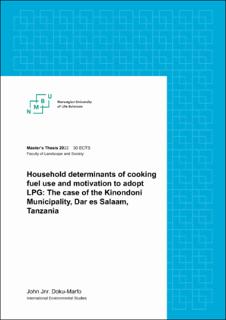| dc.description.abstract | In Sub-Saharan Africa, 70-90% of the energy supply for cooking, lighting, and heating is primarily sourced from biomass. The use of biomass, therefore, represents about 82% of the total energy consumed in the sub-region. However, the adverse impacts of household air pollution (HAP) associated with the over-reliance on traditional solid fuels contribute to global black carbon which is the second most contributing gas to climate change. In Tanzania, women, and children lose precious time for income-producing activities and education because they must gather fuel or spend time cooking with these slow, inefficient, traditional solid fuels. In addition, the pollution associated with the indoor burning of solid fuels (in traditional cookstoves) mostly under poorly ventilated conditions, causes the loss of about 33,024 lives annually. The widespread uptake of clean fuels is, therefore, necessary to improve health and reduce HAP. In this quantitative study, a cross-sectional design was adopted to obtain household information from purposively sampled Wards in the Kinondoni Municipality of Dar es Salaam, Tanzania (n=477). Three main results are reported in this study. First, the energy use pattern in all the surveyed households followed the multiple fuel use hypothesis, and households use multiple fuels (LPG, charcoal, kerosene, firewood, and electricity) for different cooking purposes. Secondly, household income, size, residential location, households’ connection to electricity, degree of buying, and unavailability of fuel highly correlate with the choice of cooking energy. Lastly, household income, fuel unavailability, frequency of refilling, the number of household inhabitants, and a household’s connection to electricity are good predictors for the choice of PAYG LPG among the surveyed households. | en_US |

